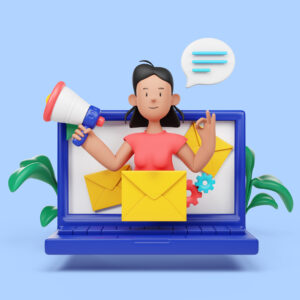When crafting an email blast, it’s crucial to focus on how to captivate your audience and drive meaningful conversions. An effective email blast doesn’t just reach inboxes; it engages and compels recipients to take action. Understanding the key elements of a successful email blast can transform your email marketing strategy and boost your overall results.
We strongly recommend that you check out our guide on how to take advantage of AI in today’s passive income economy.
Table of Contents
Understanding the Core Elements of an Email Blast
Crafting an Engaging Subject Line
The subject line of your email blast is the gateway to your content. It’s the first impression your recipient will have, so make it count. A compelling subject line grabs attention and entices readers to open your email.
Focus on clarity and relevance. Avoid vague or overly complex language. Instead, use actionable words that clearly convey the benefit or value of opening the email. Personalizing the subject line with the recipient’s name or location can also enhance its effectiveness.
Keep it concise; subject lines that are too long may get cut off, especially on mobile devices. Aim for 40-50 characters to ensure your message is fully visible. Testing different subject lines through A/B testing can provide insights into what resonates best with your audience.
Designing for Visual Appeal
An eye-catching design is integral to a successful email blast. Visual elements should complement the text and guide readers through the content. Use a clean, professional layout with ample white space to avoid overwhelming your audience.
Incorporate high-quality images that support your message and drive engagement. Ensure that these visuals are optimized for fast loading times. Including clear, prominent calls to action (CTAs) within the design will help direct recipients to the desired action.
Consistency in design across all emails helps build brand recognition and trust. Use your brand’s colors, fonts, and logo to create a cohesive look that aligns with your overall marketing strategy.
Writing Content That Converts
Creating a Compelling Opening
The opening of your email blast should immediately capture the reader’s interest. Start with a strong, relevant hook that addresses a pain point or offers a solution. This approach engages the reader and encourages them to continue reading.
Be direct and focused on the value you’re offering. Avoid lengthy introductions that may lose the reader’s attention. Instead, quickly highlight the main benefits or key points of your email blast to keep the reader engaged.
Personalization in the opening can significantly impact conversion rates. Tailoring content to address specific needs or interests of the recipient helps create a more personalized experience, which can drive higher engagement and conversion.
Structuring Your Message for Impact
Effective email blast content is structured to maintain the reader’s interest throughout. Use short paragraphs and bullet points to break up text and make it easier to scan. Highlight key information and benefits in a way that is visually distinct.
Include a clear call to action (CTA) that tells the reader exactly what you want them to do next. The CTA should be prominent and actionable, using persuasive language that encourages immediate response.
Ensure that the content is relevant and valuable to the recipient. Focus on providing solutions or benefits that directly address their needs or interests. Avoid overly promotional language, and instead, offer useful information or incentives that drive conversions.
Testing and Analyzing Your Email Blast Performance
A/B Testing for Optimization
A/B testing is a valuable tool for refining your email blast strategy. By testing different versions of your email, you can determine which elements perform best and make data-driven decisions to improve your results.
Start by testing different subject lines, content formats, or CTAs. Monitor key metrics such as open rates, click-through rates, and conversion rates to evaluate performance. Use the insights gained from these tests to refine your approach and enhance future email blasts.
Regularly testing and analyzing your email blasts ensures that you continually optimize your strategy based on real data. This iterative process helps you stay aligned with your audience’s preferences and maximize the effectiveness of your campaigns.
Tracking Key Metrics and Analyzing Results
Tracking the performance of your email blast is essential for understanding its impact and identifying areas for improvement. Key metrics to monitor include open rates, click-through rates, conversion rates, and bounce rates.
Use these metrics to assess how well your email blast resonates with your audience and whether it drives the desired actions. Analyzing results allows you to make informed decisions about future campaigns and adjust your strategy to better meet your goals.
Incorporate feedback from recipients and learn from both successes and failures. This continuous improvement process will help you refine your email blast approach and achieve better results over time.
Final Thoughts
Crafting an effective email blast that drives conversions requires a strategic approach. By focusing on engaging subject lines, compelling content, and visually appealing design, you can capture your audience’s attention and encourage them to take action.
Regular testing and analysis of your email blasts will help you optimize your strategy and achieve better results. Remember to keep your content relevant and valuable to your recipients, and always be prepared to adjust your approach based on performance data.
Implement these strategies to create email blasts that not only reach your audience but also drive meaningful conversions and contribute to your overall marketing success.
FAQs:
What is an email blast?
An email blast refers to sending a single email to a large group of recipients at once. It’s typically used for marketing or promotional purposes, aiming to reach a broad audience quickly. Email blasts are designed to communicate messages such as product announcements, special offers, newsletters, or updates to a wide range of subscribers. The key element is that the same message is sent to all recipients, making it a mass distribution tool for businesses to engage with their audience.
How do I send an email blast?
To send an email blast, follow these steps:
- Choose an email marketing platform – Use services like Mailchimp, Constant Contact, or HubSpot to manage and send your email blasts.
- Build or segment your email list – Compile your list of contacts or segment them based on interests, demographics, or previous interactions for more targeted blasts.
- Create your email – Design your email with engaging content, visuals, and clear calls to action (CTAs). Focus on making the email concise, visually appealing, and relevant to your audience.
- Craft a compelling subject line – The subject line is crucial for getting people to open your email. Make it catchy, direct, and aligned with the content.
- Test your email – Before sending, test your email on different devices and platforms to ensure it appears correctly. Many email platforms allow you to send test emails.
- Schedule or send your email blast – Choose the best time to send your email based on your audience’s habits and preferences. You can either send it immediately or schedule it for a future date.
- Monitor performance – After sending, track key metrics like open rates, click-through rates, and conversion rates to gauge the success of your email blast.
What is the professional way to say email blast?
Instead of using “email blast,” professionals often use terms like email campaign, mass email, bulk email, or email distribution. These terms sound more refined and suggest a structured, strategic approach to email marketing rather than a simple mass send. Using phrases like email marketing campaign or email outreach also highlights the intent and sophistication of the process.
Does email blasting work?
Yes, email blasting can be an effective marketing tool when done correctly. Its success depends on several factors, including the relevance of the content, the quality of your email list, and how well you target your audience. Well-crafted email blasts can lead to high engagement, drive conversions, and increase brand awareness. However, if not done properly—such as sending irrelevant or too frequent emails—an email blast can result in low engagement, unsubscribes, or emails landing in the spam folder. Personalization and segmentation improve the effectiveness of email blasts by ensuring that recipients receive content that matters to them.

We strongly recommend that you check out our guide on how to take advantage of AI in today’s passive income economy.




